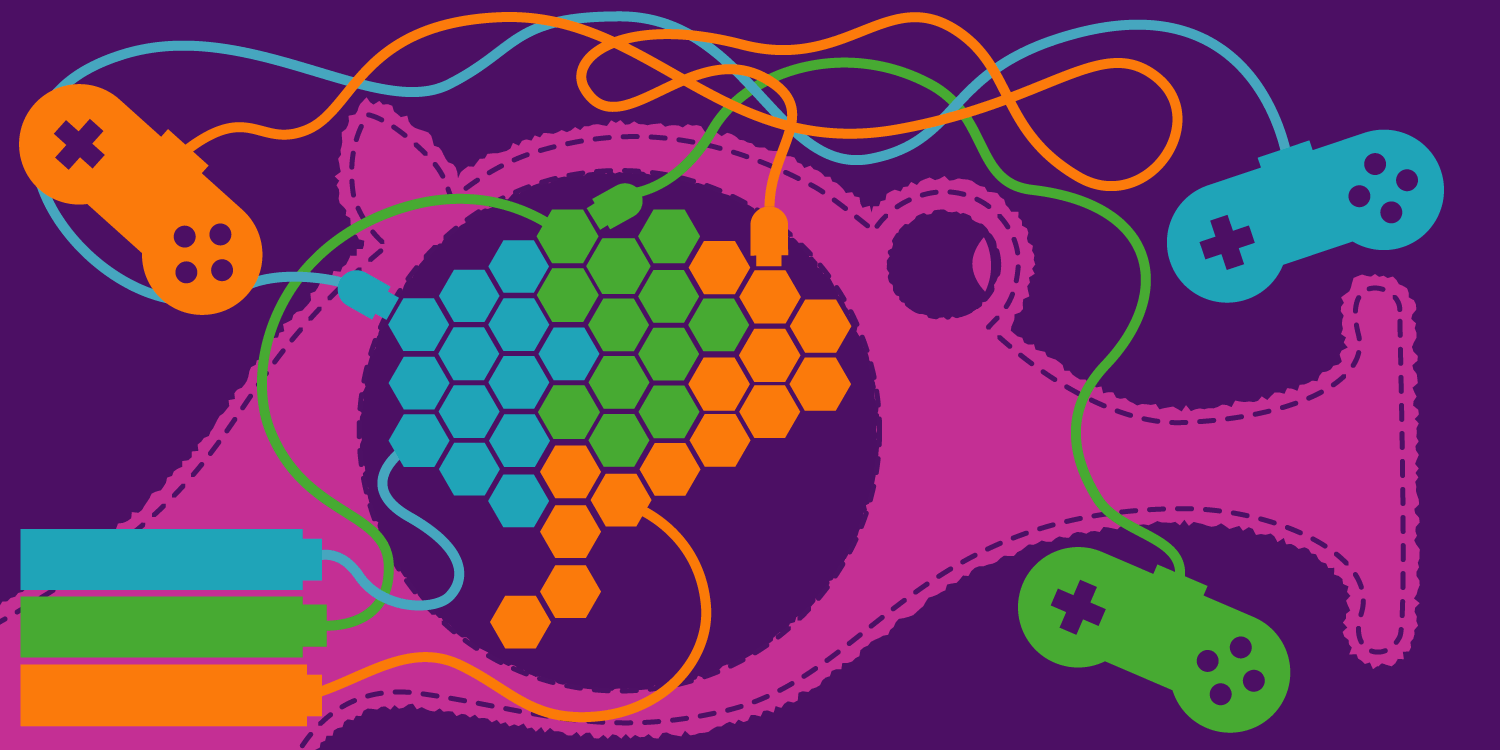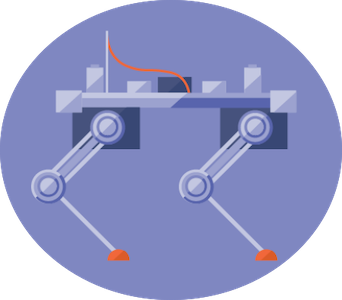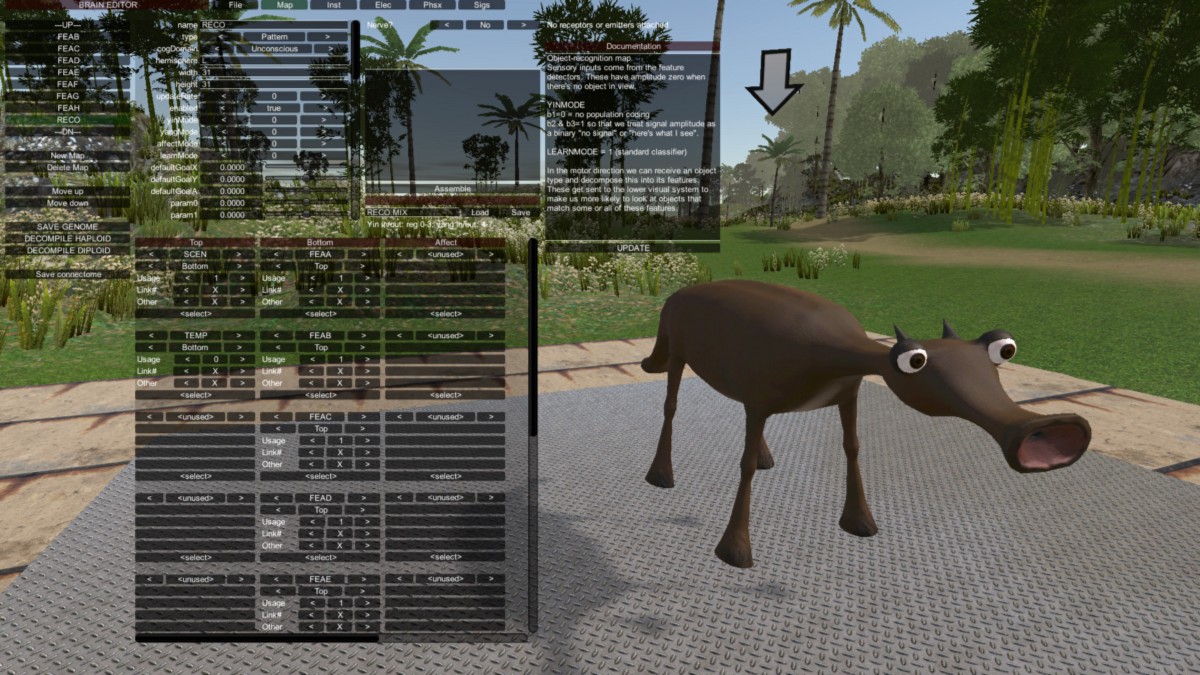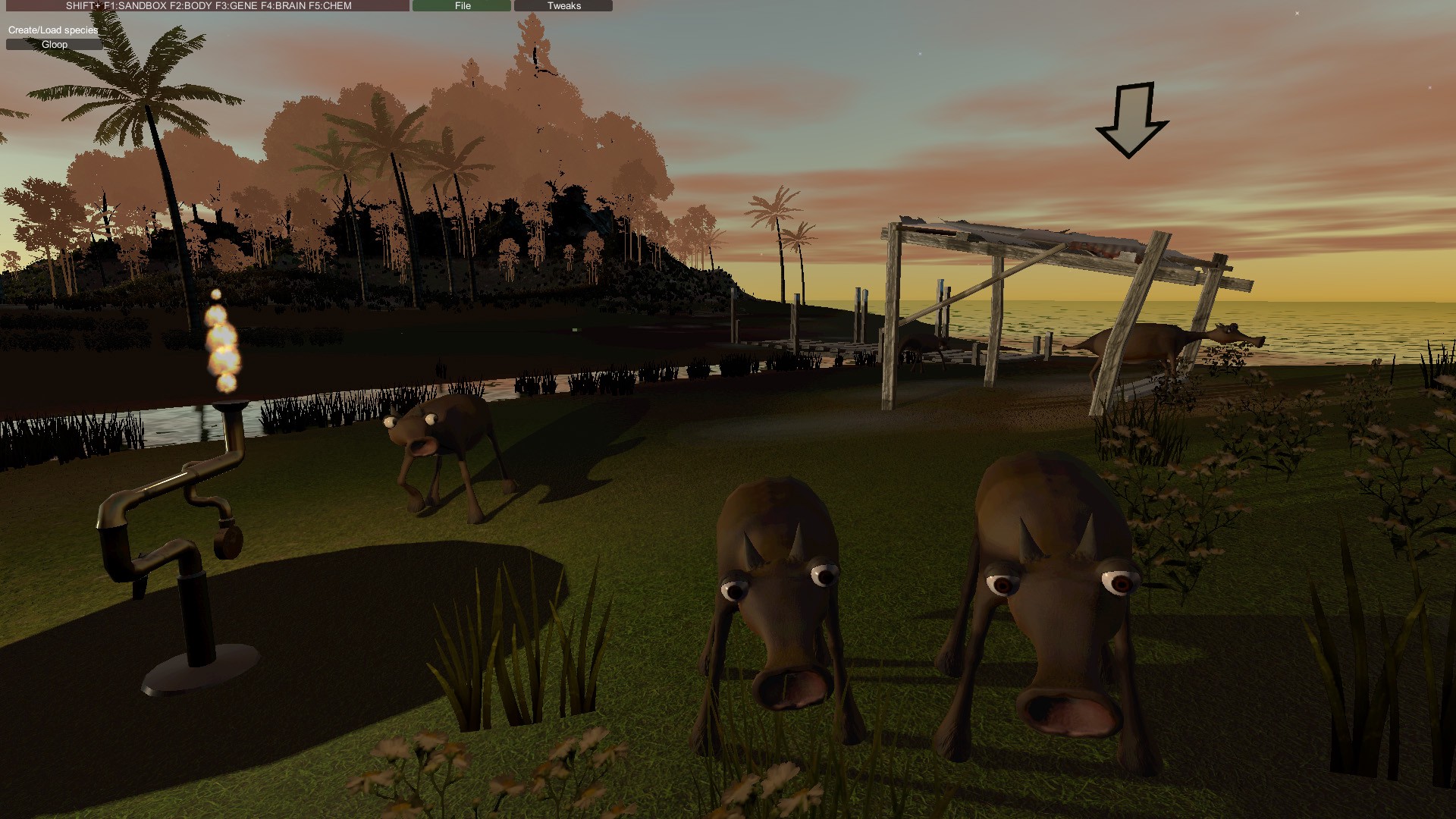

Steve Grand is currently teaching his children how to pee. Not the physical act of urinating–that end of the process isn’t particularly interesting to the British inventor. Rather, he’s teaching them to notice that mental niggle with which we’re all familiar, the sense of a mounting pressure in some deep place that clues us to the fact that our bladder is full and we need to do something about it, quickly.
Grand’s children–this current batch, at least–have taken their father’s name. The Grandroids, as they’re known, are bug-eyed, quadrupedal animals. They look a bit like shaven dogs with giant octopus suckers for mouths (although that may radically change in the coming months). Compared to the kinds of lavishly rendered virtual creatures that roam many contemporary video games, the Grandroids appear prehistorically basic. Appearances deceive: behind their shrill eyes tick extraordinary virtual minds–ones that, if you believe the claims of this reclusive neuro-inventor, are the closest our species has come to birthing artificial life.

Before you dismiss Grand as a quack–he did flunk out of school when growing up in a cathedral town in Britain’s West Country–it’s important to know that he has precedence in this area. Grand was the designer of Creatures, a 1996 artificial life simulator in which players raised alien creatures known as Norns, teaching them how to survive, breed, and even learn some rudimentary language.
The project brought Grand widespread attention. He was invited to address a conference of researchers from the Human Genome Project. He was given an honorary doctorate. He was appointed as an Officer of the Most Excellent Order of the British Empire. Creatures also ignited an interest in artificial life for a swathe of young players, who researched cures for virtual diseases, carried out breeding experiments, formed adoption agencies, and even published scientific papers on their findings. Grand boasts that he still regularly receives letters from doctors, scientists, and developers who “owe their careers” to what they learned through the software.
Grand’s next notable project moved from the domain of pixels to that of atoms. Lucy, a robotic, legless orangutan was said to be the world’s most artificially intelligent robot of the early 2000s. Compared to the pomp of that label, Grand’s appraisal was rather more modest. Lucy was able to track people with her eyes as they moved around the room (a skill rendered rather terrifying on account of her ill-fitting skin and lidless eyes), but she was about as intelligent as a frog, he offered. Nonetheless, Grand’s book about his journey, Growing up with Lucy: How to Build an Android in Twenty Easy Steps, is now a classic text for both AI and robotics enthusiasts.

Even with this heritage, Grand’s vision for his current project, which was initially laid out in his Kickstarter campaign to raise funds for Grandroids in 2011, seems preposterously ambitious. In his pitch, he claimed that he would create “real alien life forms” that can live in a virtual world on your computer. “I do mean real,” he wrote. “I’m not talking about a computer game designed to simulate lifelike behaviour; I mean genuine artificial life. I mean virtual creatures constructed from complex networks of virtual brain cells and biochemical reactions and genes.”
“I get up at 7:30, sit in front of a computer, suddenly discover it’s midnight, and go to bed. On a good day I may remember to eat.”
Many bought into the concept. The campaign raised more than $50,000. Since offering a rudimentary demo to his backers in April 2014, however, things have gone a little quiet. Grand hasn’t posted a single update in more than 18 months (although he does keep a diary on a special, backers-only website, where the latest code is also available). The public silence, he said, does not bespeak inactivity. In fact, he’s simply been too busy working on the project to issue reports.
“I get up at 7.30, sit in front of a computer, suddenly discover it’s midnight, and go to bed,” Grand said. “On a good day I may remember to eat.” The slow pace of the work is a result of the way in which the inventor, who now lives in Arizona close to the Grand Canyon, is approaching the problem of creating artificial intelligence. As he suggested in the Kickstarter pitch, he is not mimicking the behavior of real-world animals in code, as is the usual practice in video games and other simulators. Instead, he is trying to replicate the machine that is the living body, on an almost cellular level, by creating networks of virtual neurons, enzymes, receptors, and genes. These systems are then clicked together like Lego blocks. It’s the arrangement of these elements and objects that dictates the creature’s behavior, rather than the code inside them.

In other words, it’s not enough to program a Grandoid to, say, pee a set amount of time after it drinks some water. Instead, the biological process of waste production must take place inside the creature and the code, resulting in a message being sent to the virtual creature’s brain, informing it of its need. “I’ve “‘wired’ dozens of virtual muscles directly to each creature’s “‘brain,'” Grand said. “These interact with a physics engine, so that movements and choices are as real as possible.” It is, as he put it bluntly, “a f***ing huge undertaking.”
“Right now, I’m working on their biochemistry, starting with metabolism. I can’t move on any further with their brains until they have some reasons to live.”
Still, he is a man who, as the writer Jon Ronson said in a 2002 profile for The Guardian, “is only interested in doing things the hard way.” In fact, Grand views Grandroids as a vast, ongoing, open project that may not “ever actually be finished.” “They remind me of me as a child,” he said. “Until I’ve finished building their brains and all their other systems, it’s too early to tell what their personalities will be like.” This work requires expertise in a range of different scientific disciplines. Some days Grand comes to work as a programmer. Others days, as a biologist, neuroscientist, or even psychologist. “Right now, I’m working on their biochemistry, starting with metabolism. I can’t move on any further with their brains until they have some reasons to live. It’s fun to be getting on to some relatively straightforward biology at last, instead of building infrastructure.”
This work is further complicated by the fact that the living brain is such an arcane entity. If Grand wanted, for example, to create a fully functioning, virtual car engine from digital bolts, screws, pistons, fuel, and oil, then there would be schematics he could follow and an understanding of the physics involved in converting fuel to energy to mechanical movement. When it comes to the brain there are no maps. “We barely have a clue as to the fundamental operating principles of the brain,” he said. “There’s probably no structure in the universe about which we know so much and yet understand so little.” Indeed, this absence of understanding about our own brains is a major factor in Grand’s work. “This is what artificial life is all about, really,” he said. “We’re using computer models to generate insight and inspiration about the underlying principles of biology.”

Almost five years since he first began work on the project, the Grandoids are still, on the surface, rather unimpressive. “It’s in the nature of the bottom-up approach to AI that all the juicy stuff starts to happen at the end,” Grand explained. Currently the creatures are only able to hunt and eat their prey (small, green, hopping creatures called throgs, named after the animals featured in the computer scientist A. K. Dewdney’s book The Planiverse). Grand is indignant about the magnitude of this seemingly minor achievement. “Chasing throgs is a far more complex process than at first it appears,” he said. “They have to coordinate dozens of virtual muscles to be able to walk, modify their gaits to cope with slopes and to turn in a given direction, and then convert the stimuli whizzing across their retinas into a more stable and useful set of reference frames.”
“They then need to dream about their day so as to consolidate their memories.”
They also have to navigate around obstacles, plan a route to reach their prey, and execute the plan via their muscles. While they’re doing this, the creatures are, apparently, learning about their territory and memorizing more complex routes around the world. “They gradually develop a mental map of this territory, and if they can’t see any throgs right now then they’ll remember where they last saw some and plan a route across their island to go and hunt for some,” he said. At night the animals become sleepy and lie down because the urge to rest becomes greater than their urge to hunt. “They then need to dream about their day so as to consolidate their memories.”
When Grand breaks the complexity of hunting down into its constituent mental and muscular components, the vast scale of the endeavor becomes apparent. That he is doing this alone–he has no funding from any scientific bodies–only makes the undertaking all the more unusual and foreboding. Even once things are working in a “biologically and psychologically satisfying way,” as he put it, there’s still the issue of how to debug the work. “It’s a bit like studying a paranoid schizophrenic’s rambling fantasies and trying to figure out exactly which neurotransmitters might be misbehaving,” he said.

Nevertheless, progress is steady. “I think I can just about see light at the end of the tunnel now,” Grand said. “It’s a huge undertaking for one lone programmer, but I work best when I can keep the whole thing inside my head, follow up hunches without needing to write proposals or attend meetings, and stick to my vision without a bunch of people pulling [me] in different directions or getting antsy when I miss a deadline. The price of that privilege is living like an impoverished hermit.”
Despite his apparent lax approach to schedules, he is working to a plan. He hopes to have something he can release as a commercial product “before there’s a new president” in the States, which means sometime during 2016. Once the software is out, he believes it will assume a life of its own, which he can help shape and support. “I like to think of myself as the proprietor of a pet shop that sells aliens,” he said. “I’ll only have one or two species available at first, but while people are busy figuring out how best to look after them, what to do when they get sick, how to teach them new things and so on, I’ll be busy scouring the galaxy for others.”
“The problem AI has always had is the need to prove itself, and that leads to short-term solutions and short-term thinking.”
Surely Grand’s backers, which include two personal friends who are supplementing the Kickstarter funds, require harder evidence of practical application for his discoveries? The inventor believes that this is a short-sighted way of looking at things. “The problem AI has always had is the need to prove itself, and that leads to short-term solutions and short-term thinking,” he said. “If AI is like trying to get to the moon, and one person finds a way to jump a foot higher than everyone else, that’s touted as progress, but in truth you’ll never reach the moon by jumping. Work like mine is aimed more towards long-term solutions. It assumes that the ability to think like a human being is the very tip of a huge iceberg that necessarily begins with trying to walk, learning your way around, understanding what roughness is, why things fall over, how to recognize mom. I think there will be many applications for artificial animals–look at how many things horses could do that tractors can’t–but there’s a long way to go.”
Grand believes that when it comes to recreating a brain we must learn to walk before we can run. “We probably know more facts about this three-pound lump of fat than we do about any other single structure in the universe,” he said. “But we still don’t really have a clue what its fundamental principles of operation are, nor how to replicate them. There is a great deal of hype in this business, so, one way or another, making technological predictions is a bit tricky and liable to be misinterpreted. I try not to think about applications anyway, because it becomes too tempting to make something that solves only one problem and that’s not what intelligence is about. All I can say is, “‘build it and they will come.'”

The popular tone around AI, at least in the media and fiction, is one of fear and wariness. This angst has been amplified by ill-portents from the mavens and professionals. Stephen Hawking recently warned that advanced AI “could spell the end of the human race.” Elon Musk claimed that artificial intelligence is the greatest existential threat to mankind. During a Q&A session on Reddit, Bill Gates wrote: “I agree with Elon Musk and some others on this and don’t understand why some people are not concerned.” German philosopher Thomas Metzinger has argued that the prospect of increasing the amount of suffering in the world is so morally awful that we should cease building artificially intelligent robots immediately.
Grand, ever the outlier, roundly dismisses these claims. “Certain people are spreading a lot of fear about AI lately, and in many cases this is unfounded nonsense,” he said. “They still have the assumption that the automation which today calls itself AI will somehow lead to sentient, generally intelligent beings. They’re wrong. Intelligence of the kind they’re talking about is just the tip of a huge iceberg, and without the part that’s underwater there’s no hope that this tip will stay afloat.” As evidenced by his project, Grand believes that real and general artificial intelligence will come about through making dumb artificial animals, and he said, the result will be different from the cold, ruthless killing machines that people like to fantasize about. “To get to the top, we must start at the bottom and work up, and right now we still don’t have a clue where to begin. So there’s a long way to go before any of the stuff people like me are doing is directly useful, but we might learn a few interesting things on the way.”
Indeed, he thinks that the great steps we believe we’ve taken to date in AI–the chatbots, the grand master chess applications–are, in fact, rather insignificant. “Playing chess is a trivial problem compared to sitting on a chair, or remembering your way home,” he said. “I just took the trash out, and when the wind started to catch the empty boxes I was carrying, I shifted things around and swapped stuff from hand to hand so that the wind would blow the boxes closer to my chest and I’d be able to throw them in the dumpster more easily when I got there. Now that is intelligence. I know we’ll have cracked AI when a machine that wasn’t designed specifically for the task can learn how to tie its own shoelaces. Taking over the world is peanuts compared to that.”


How We Get To Next was a magazine that explored the future of science, technology, and culture from 2014 to 2019. This article is part of our Robots vs Animals section, which examines human attempts to build machines better than nature’s. Click the logo to read more.
